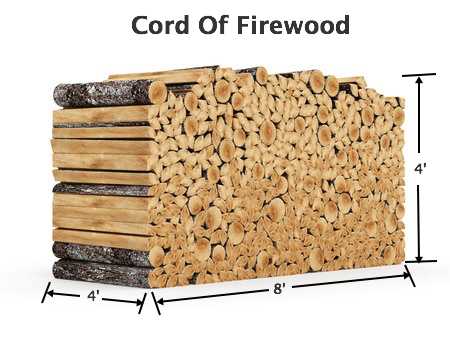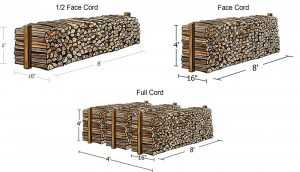Some homeowners love to burn wood in their fireplace or stove for heat. The firewood is sold in the form of a standard measure called “Cord.” The regulations and policies to sell firewood cords vary from country to country and state to state.
In the following article, we will define these terms and guide you to the average cost of firewood cord you should be paying.
Explaining Cord of Firewood
It’s okay for people looking to split firewood for their personal uses to avoid measuring a firewood cord down to the last inch. However, if you plan to purchase firewood, it’s essential to understand what terminology like “cord” means. Words like “cord” refer to a measurement used for stacks of firewood.
Measurements
By definition 1 cord of wood = 4ft x 4ft x 8ft. You can also think of this as a volume. Based on these measurements, a cord fills up 128 cubic feet of space. Although, in actuality, the wood volume is closer to 90 cubic feet due to the air pockets between the stack. It’s assumed that the wood is stacked parallel, touching, and compact to minimize these air pockets.
Cords of firewood are also relatively cumbersome. In case hardwood is used, a cord can weigh up to 5,000 lbs, and for softwood is used, it may only weigh 2,500 lbs.
There are different ways to stack firewood, but the full cord arrangement is the best common way to stock. Thus, many people see various measures and numbers when it comes to firewood and its complete arrangement.
It is where the laws of different states come into play. For instance, in unregulated states, firewood can be sold by the cord or fractions of a cord called a “face.” Some states also allow firewood to be sold by fractions as well. A face cord is simply one row of wood measured as 4′ x 8′ x length of the pieces.

Face Cord vs. Full Cord
Homeowners that use firewood to heat their rooms or homes know very well that a 4-feet or 48-inch log won’t fit well in their fireplace. It is why firewood is cut into what is known as a furnace cord or a face cord.
A standard full cord of firewood measures- 4′ H x 8′ L x W (In this case, W = 48″)
However, with fractions of a cord, you can get 1/4, 1/3, or 1/2 face cords.
- A face cord of 12″ lengths is a 1/4 cord or 32 cubic feet.
- A face cord of 16″ lengths is a 1/3 cord or 42.7 cubic feet.
- A face cord of 24″ lengths is a 1/2 cord or 64 cubic feet.

Valuing a Cord of Firewood
From the above topic, you are now familiar with measuring firewood; here, we will guide you for the validation process while buying or selling firewood.
Before looking at the numbers, it’s essential to understand each type of firewood is unique. It’s the same with almost any other resource because the quality and quantity can differ. For instance, you need to take into account:
- How dry the firewood is (dry is better for burning purposes)
- How clean the firewood is (cleaner wood is more comfortable to burn)
- How thick the firewood is (thinner logs are not as easy to manage)
- How uniform the logs are (properly split logs are better)
The above factors play an important role in the cost of the cord. The season is another important aspect, as you have to pay more in the winter season. On average, you can expect to pay $150-$200 for a cord of wood. During the winter months, you may spend upwards of $400-$500 a cord.
Conclusion
When it comes to units to measurement, a cord is the best way to measure stacks of wood. Depending on your location, you have the option to buy firewood as a full cord or fractions of a cord. Most people tend to measure firewood with a face cord or furnace cord because it’s more in line with how the logs are used.
Make sure always to check the quality of firewood. It is the only best way to come out on the right side of the deal without overpaying or underselling.